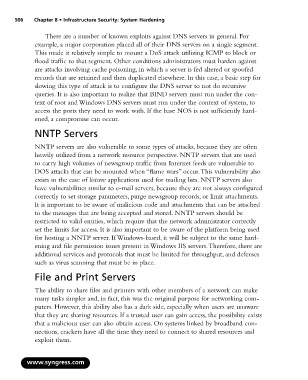Page 522 - StudyBook.pdf
P. 522
506 Chapter 8 • Infrastructure Security: System Hardening
There are a number of known exploits against DNS servers in general. For
example, a major corporation placed all of their DNS servers on a single segment.
This made it relatively simple to mount a DoS attack utilizing ICMP to block or
flood traffic to that segment. Other conditions administrators must harden against
are attacks involving cache poisoning, in which a server is fed altered or spoofed
records that are retained and then duplicated elsewhere. In this case, a basic step for
slowing this type of attack is to configure the DNS server to not do recursive
queries. It is also important to realize that BIND servers must run under the con-
text of root and Windows DNS servers must run under the context of system, to
access the ports they need to work with. If the base NOS is not sufficiently hard-
ened, a compromise can occur.
NNTP Servers
NNTP servers are also vulnerable to some types of attacks, because they are often
heavily utilized from a network resource perspective. NNTP servers that are used
to carry high volumes of newsgroup traffic from Internet feeds are vulnerable to
DOS attacks that can be mounted when “flame wars” occur.This vulnerability also
exists in the case of listserv applications used for mailing lists. NNTP servers also
have vulnerabilities similar to e-mail servers, because they are not always configured
correctly to set storage parameters, purge newsgroup records, or limit attachments.
It is important to be aware of malicious code and attachments that can be attached
to the messages that are being accepted and stored. NNTP servers should be
restricted to valid entities, which require that the network administrator correctly
set the limits for access. It is also important to be aware of the platform being used
for hosting a NNTP server. If Windows-based, it will be subject to the same hard-
ening and file permission issues present in Windows IIS servers.Therefore, there are
additional services and protocols that must be limited for throughput, and defenses
such as virus scanning that must be in place.
File and Print Servers
The ability to share files and printers with other members of a network can make
many tasks simpler and, in fact, this was the original purpose for networking com-
puters. However, this ability also has a dark side, especially when users are unaware
that they are sharing resources. If a trusted user can gain access, the possibility exists
that a malicious user can also obtain access. On systems linked by broadband con-
nections, crackers have all the time they need to connect to shared resources and
exploit them.
www.syngress.com

